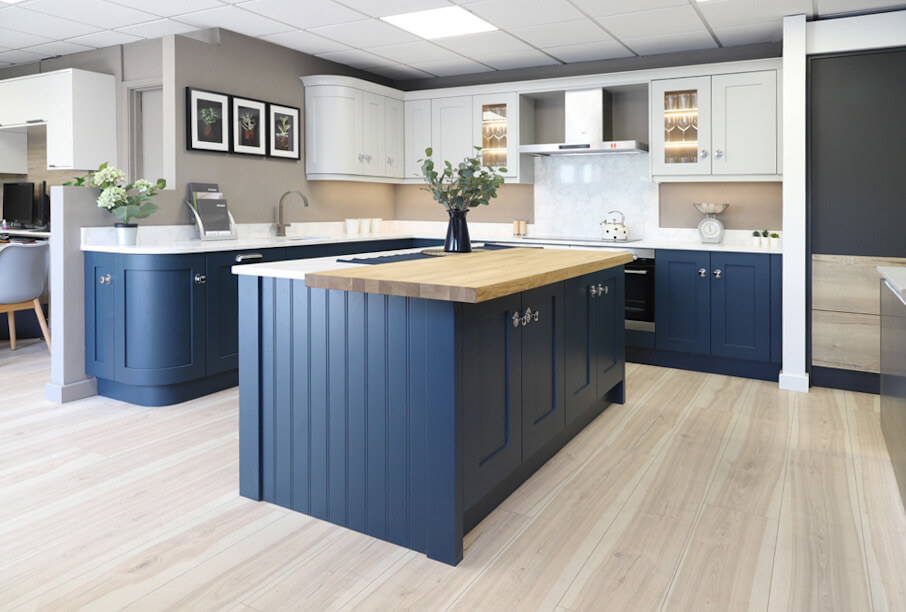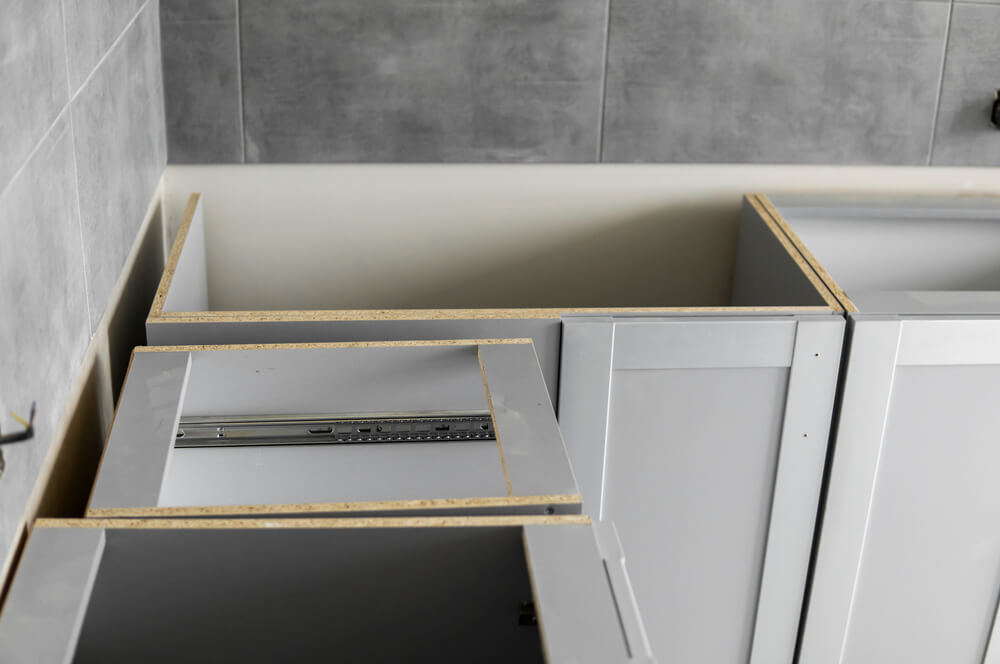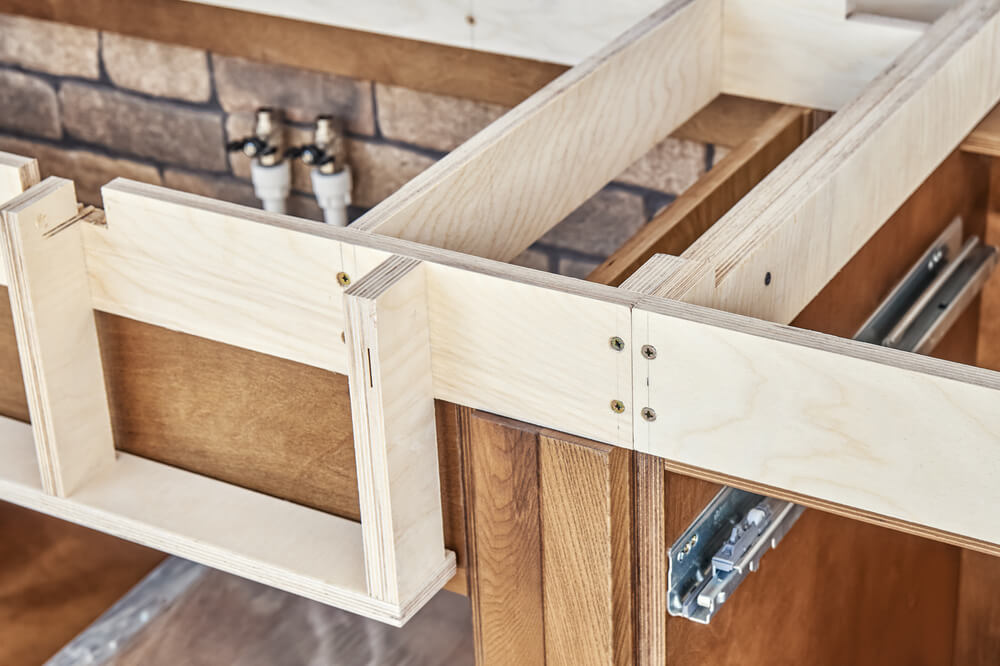
Cabinets will take up a large proportion of your kitchen’s design. The colour, material and type you choose will heavily impact the overall impression and finish of your kitchen.
Choosing wisely the best material for your kitchen cabinets is key to how you can design and present this space, especially if you use this room often for entertaining. The material you end up using in your design will greatly influence the potential colour scheme of your kitchen.
Here at KNB, we have detailed a guide to choosing the best and most popular materials to use for your kitchen cabinet and the pros and cons of each.
MDF for Kitchen Cabinets

MDF stands for ‘Medium Density Fibreboard’ and is a wood particle blend mixed with wax and a resin binder, before being compressed into panels. This makes for a dense wood-like material that can be cut into a variety of shapes and coated in a laminate design of choice.
Pros of MDF
- Even surface. The nature of construction of MDF makes it a smooth surface to apply laminate or wood veneer on.
- Sizing. MDF creates bigger panels than traditional wood, making it good for larger cabinets.
- Warp and moisture resistant. As it is created with wax and resin, there is a good water tightness, especially with care.
- Easy to paint. If a laminate has not been applied, you can paint on MDF easily.
Cons of MDF
- Susceptible to sagging. If you overload shelves or constantly push against the back panel, then the MDF will sag over time.
- Weaker than other materials. Compared to stainless steel or consistent panel pieces from natural wood, MDF is weaker.
- Heat resistance. Due to the construction methods used, MDF is not suitable for extremely high temperatures.
Plywood for Kitchen Cabinets

Created from multiple layers of wood that are laminated and glued together with a veneer. Plywood is available in grades, where AA is the highest and E is the lowest. When the direction of the grain of each piece of wood is varied, plywood is at its strongest.
Pros of Plywood
- Low-cost material. The quality of plywood, along with the finish, makes it look higher end, but it is largely affordable, varying between £11 and £30 per square metre.
- Strong. The weight to strength ratio of plywood is high, as although it is lightweight, it is still very strong.
- Easily repairable. If plywood gets chipped, they can be easily sanded down or filled with no noticeable defects.
Cons of Plywood
- Thinner plywood can break. If used incorrectly, thinner plywood will snap. Thinner layers should be used to back cabinets, and thicker layers to build the shelves.
- Inconsistencies. Plywood can have gaps or knots in it, so for some people unfamiliar with carpentry, it can cause problems.
Stainless Steel Kitchen Cabinets

Often associated with industrial cabinets, stainless steel is an unsuspecting choice for modern kitchens, or those who want an industrial grade kitchen. While you are limited in colour choice, stainless steel looks sleek and, when paired correctly, looks incredibly stylish.
Pros of Stainless Steel
- Stain resistant. A quick wipe down will remove any surface spills.
- Won’t warp. Unlike woods, which can warp in high heat or humidity, steel won’t warp at all.
- Durable. Steel will last for ages, and is incredible at resisting fire, water, and other damages.
Cons of Stainless Steel
- Prone to dents and scratches. While it is durable, dents may leave permanent marks, and steel is difficult to repair after it has been scratched.
- Doesn’t suit a lot of styles. Unlike woods, stainless steel does not suit every kitchen. They will often need to be placed in a contemporary home with a large kitchen to suit properly.
Hardwood or Solid Wood Cabinets

Carved from natural resources, solid wood cabinets are entirely organic and unique. No two designs are the same, and this can add natural character to your cabinets. You can even choose the type of wood you want to feature in your cabinets, from local woods to more exotic ones.
Pros of Solid Wood
- Natural materials. For those wanting a more sustainable kitchen, wood can provide a locally sourced alternative to manufactured materials.
- Highly durable. Wood has been used to craft ships and other key structures for centuries, some of which still stand the test of time today.
- Variety of colours. By choosing a different type of wood, you can style your kitchen in unique ways. Wood can also be painted without compromising the natural textures.
Cons of Hardwood
- Weight. Wood is a heavy material and, if not constructed or installed properly within your kitchen design, will impact the longevity of the hinges it rests on.
- Expensive. As wood must be sourced naturally, it is also high quality, and therefore tends to be a costlier material compared to the likes of MDF.
- Different varieties have different durability. Whilst wood is highly durable, softer woods such as pine will potentially not last as long if treated badly.
For your kitchen cabinet needs, make sure to get in contact with KNB, who can assist at every step of the kitchen design journey.
